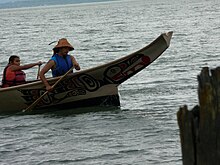
The San Juan Islands is an archipelago in the Pacific Northwest of the United States between the U.S. state of Washington and Vancouver Island, British Columbia, Canada. The San Juan Islands are part of Washington state, and form the core of San Juan County.

Whatcom County is a county located in the northwestern corner of the U.S. state of Washington, bordered by the Lower Mainland of British Columbia to the north, Okanogan County to the east, Skagit County to the south, San Juan County across Rosario Strait to the southwest, and the Strait of Georgia to the west. Its county seat and largest population center is the coastal city of Bellingham, comprising the Bellingham, WA Metropolitan Statistical Area, and as of the 2020 census, the county's population was 226,847.
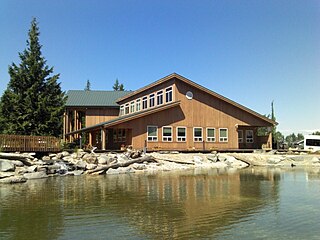
The Squaxin Island Tribe are the descendants of several Lushootseed clans organized under the Squaxin Island Indian Reservation, a Native American tribal government in western Washington state.

The Duwamish are a Lushootseed-speaking Southern Coast Salish people in western Washington, and the Indigenous people of metropolitan Seattle.

The Sauk-SuiattleIndian Tribe is a federally-recognized tribe of Sauk people located in western Washington state. The tribe historically lived along the banks of the Sauk, Suiattle, Cascade, Stillaguamish, and Skagit rivers, in the area known as Sauk Prairie at the foot of Whitehorse Mountain in the North Cascade Range.

The LummiNation is a federally-recognized tribe of primarily Lummi people. The Lummi Nation also includes some Nooksack, Samish, and other local tribes which were removed to the reservation. It is based in the coastal area of the Pacific Northwest region of Washington state in the United States, and is located within the Bellingham Metropolitan Area

The Swinomishpeople are a historically Lushootseed-speaking Native American people in western Washington state in the United States. The Tribe lives in the southeastern part of Fidalgo Island in northern Puget Sound, near the San Juan Islands, in Skagit County, Washington. Skagit County is located about 70 miles (110 km) north of Seattle.
Lushootseed, formerly known as Puget Salish, Puget Sound Salish, or Skagit-Nisqually, is a Central Coast Salish language of the Salishan language family. Lushootseed is the general name for the dialect continuum composed of two main dialects, Northern Lushootseed and Southern Lushootseed, which are further separated into smaller sub-dialects.
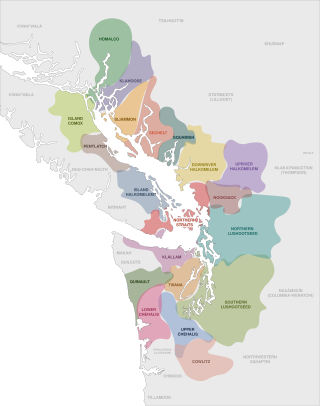
The Coast Salish languages, also known as the Central Salish languages, are a branch of the Salishan language family. These languages are spoken by First Nations or Native American peoples inhabiting the Pacific Northwest, in the territory that is now known as the southwest coast of British Columbia around the Strait of Georgia and Washington State around Puget Sound. The term "Coast Salish" also refers to the cultures in British Columbia and Washington who speak one of these languages or dialects.
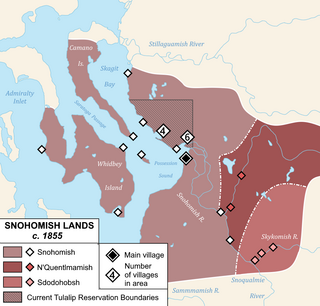
The Snohomish people are a Lushootseed-speaking Southern Coast Salish people who are indigenous to the Puget Sound region of Washington State. Most Snohomish are enrolled in the Tulalip Tribes of Washington and reside on the reservation or nearby, although others are enrolled in other tribes, and some are members of the non-recognized Snohomish Tribe of Indians. Traditionally, the Snohomish occupied a wide area of land, including the Snohomish River, parts of Whidbey and Camano Islands, and the nearby coastline of Skagit Bay and Puget Sound. They had at least 25 permanent villages throughout their lands, but in 1855, signed the Treaty of Point Elliott and were relocated to the Tulalip Reservation. Although some moved to the reservation, the harsh conditions, lack of land, and oppressive policies of the United States government caused many to leave.

The Chimakum, also spelled Chemakum and Chimacum Native American people, were a group of Native Americans who lived in the northeastern portion of the Olympic Peninsula in Washington state, between Hood Canal and Discovery Bay until their virtual extinction in 1902. Their primary settlements were on Port Townsend Bay, on the Quimper Peninsula, and Port Ludlow Bay to the south.
The Samish are a Native American people who live in the U.S. state of Washington. They are a Central Coast Salish people. Through the years, they were assigned to reservations dominated by other Tribes, for instance, the Swinomish Indians of the Swinomish Reservation of Washington and the Tulalip Tribes of the Tulalip Reservation. They are also enrolled in the Samish Indian Nation, formerly known as the Samish Indian Tribe, which regained federal recognition in 1996.
The Sammamish people are a Lushootseed-speaking Southern Coast Salish people. They are indigenous to the Sammamish River Valley in central King County, Washington. The Sammamish speak Lushootseed, a Coast Salish language which was historically spoken across most of Puget Sound, although its usage today is mostly reserved for cultural and ceremonial practices.

Lummi Island lies at the southwest corner of Whatcom County, Washington, United States, between the mainland part of the county and offshore San Juan County. The Lummi Indian Reservation is situated on a peninsula east of the island, but it does not include Lummi Island. The island has a land area of 23.97 square kilometres and had a population of 822 as of the 2000 census. The population nearly doubles in summer when second-home owners from Canada and the U.S. arrive for the summer months.
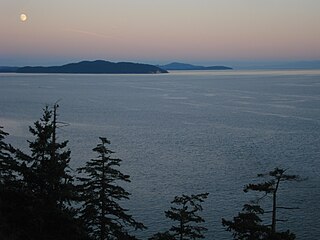
The Haro Strait is one of the main channels connecting the Strait of Georgia to the Strait of Juan de Fuca, separating Vancouver Island and the Gulf Islands in British Columbia, Canada from the San Juan Islands of Washington state in the United States.

The Coast Salish are a group of ethnically and linguistically related Indigenous peoples of the Pacific Northwest Coast, living in the Canadian province of British Columbia and the U.S. states of Washington and Oregon. They speak one of the Coast Salish languages. The Nuxalk nation are usually included in the group, although their language is more closely related to Interior Salish languages.

The Samish Indian Nation is a Coast Salish nation and a signatory to the Treaty of Point Elliott of 1855. Samish has a government-to-government relationship with the United States of America. The Samish are a Northern Straits branch of Central Coast Salish peoples. The Samish Nation is headquartered in Anacortes, Fidalgo Island, in Washington, north of Puget Sound.
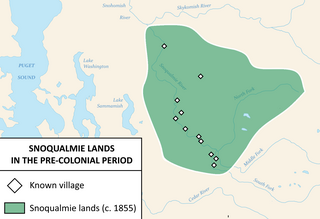
The Snoqualmie people are a Lushootseed-speaking Southern Coast Salish people indigenous to the Snoqualmie Valley, located in east King and Snohomish counties in the state of Washington.

The Mitchell Bay Band of the San Juan Islands is an indigenous Coast Salish community based in the San Juan Islands of Washington, United States. The community was first referred to as the Mitchell Bay Tribe by Office of Indian Affairs agent Charles Roblin in his 1919 Census of Unenrolled Indians, in reference to one of several bays with historically significant indigenous populations.
Lummi most commonly refers to:
